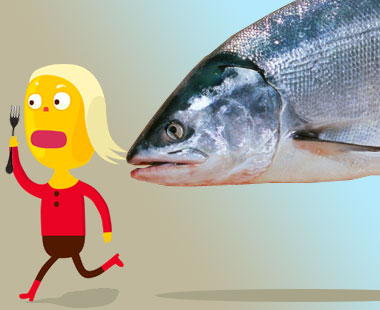
Genetically engineered salmon has consumers and environmentalists running the other way. So why is the FDA considering approving it?
Cross-posted from Gilt Taste.
For those who follow the theater of food politics, particularly the underwater portion of the drama, AquaBounty’s AquAdvantage genetically engineered salmon has played something of leading role for two decades, dating back to the 1990s when the fish was first conceived. The AquAdvantage salmon, in case you haven’t heard about it, is an Atlantic salmon with a (much larger) Chinook salmon growth gene inserted into its DNA. This is coupled with a promoter from a third fish, an ocean pout, that keeps that growth gene more or less permanently in the “on” position. This makes for a fish that grows faster than an unmodified salmon — something which its creators hail as a key to providing more fish for the world and easing the crisis in overfishing.
I have long opposed the AquAdvantage salmon, taking pretty familiar positions that any member of the local/organic/wild food community would recognize: Positions that include the fear that the fish will escape and contaminate wild populations of salmon, and that the fish requires much wasteful transport since it would be cloned in Canada, grown in Panama, and then flown back to the U.S. for consumption. But at a recent lecture when I was laying out these old chestnuts, it suddenly occurred to me that the non-fishy public might be missing one monumental fact about the AquAdvantage salmon, with all its attendant risks:
It is completely unnecessary.
Despite AquaBounty’s appeals to our concern about overfished oceans, the environmental and market advantages they claim for their genetically modified salmon are readily debunked. And while the fish is not very useful to us or the oceans, it may be, in fact, very useful to AquaBounty — in a grab to control salmon farming as we know it.
So, rather than hash out the old arguments, I thought I would lay out four somewhat fresh points that show exactly how unnecessary this particular fish really is:
Reason No. 1: There are plenty of wild salmon
AquaBounty likes to emphasize that their fish will be a way of taking pressure off of stocks of wild salmon. But there are many, many wild salmon still out there. The 2011 wild Alaska salmon harvest is projected to be one of the largest since Alaska became a state, with something like 203 million fish anticipated to be caught. These salmon are harvested under strict supervision of the State of Alaska’s Department of Fish and Game and nearly the entire Alaska salmon harvest has been certified as sustainable by the Marine Stewardship Council. Even with these intense restrictions on fishing in Alaska, we still have much more salmon than we use. As much as 50 percent of the United States’ wild salmon catch is shipped abroad in canned or frozen form, leaving one with the question: Why are we sending the cleanest, most omega3-rich protein abroad when it could be a key source of (delicious) nutrition here in the United States, particularly for children?
Reason No. 2: Farmed salmon is already pretty efficient, and getting more so without genetic engineering
In the early days of salmon farming it could take as much as six pounds of wild fish to grow a single pound of salmon. But improvements in diet, husbandry, and selective breeding programs that don’t involve genetic engineering have lowered the feed conversion ratio on the most efficient farms below two-to-one. AquaBounty claims that it could improve that efficiency by another 20 percent (a claim organizations like Food and Water Watch [PDF] dispute). But even if their claims are true, making a salmon more feed-efficient is just one of many pathways to make salmon have a smaller footprint. There are now vegetable-based salmon diets in trials that require no wild fish at all and some of these new feeds are made from recycled agricultural byproduct that might otherwise go unused. Shouldn’t improving feed be our first priority, not artificially improving salmon?
Reason No. 3: There are fish that offer many of the advantages of the genetically modified salmon, with none of the risks
For many years, conservationists have worried that farmed salmon, grown in “sea cages” where there is frequent interaction with wild fish, has led to disease transfer, escapes into the wild, and fouling of the environment. Tank, or “containment” growing, environmentalists argue, is the only safe way to farm salmon, but it is energy intensive and farmers worry that slow-growing fish would not allow a farm to cover its energy costs. One of the arguments put forward by AquaBounty is that their salmon grow so fast that they can be cost-effectively produced in out-of-ocean, re-circulating tanks that would not impact the ocean. But this barrier has already been broken with two unmodified fish. The arctic char, a fish from the same family as salmon, turns out to have a natural adaptation for living in close quarters and does well in containment facilities. Nearly all the arctic char that reaches the market today is grown in containment either in Iceland or Canada. The char’s flesh is delicate and moist like a salmon but does not have the overpowering salmon taste that many diners find off-putting. And for those who do like that salmony taste, SweetSpring of Washington state has perfected a technique for growing Pacific coho salmon entirely in containment. If these two options exist for cost-effective containment growing of salmonids, why should we even broach the possibility of genetic contamination in the form of genetically modified salmon?
Reason No. 4: People don’t seem to want it very much
Consumers have expressed distaste for a genetically modified salmon in the marketplace. If the fish is accurately labeled (as it will be in California thanks to a recent move in the state legislature) it is unlikely we will see droves of consumers flocking to buy it. Online polls by The Washington Post and the Wall Street Journal showed that only about 36 percent of consumers would willingly eat genetically modified salmon if it were labeled as such. And in European markets 0 percent would eat it. Thanks to overwhelming consumer disapproval, genetically modified foods cannot be sold in the European Union.
Why then is AquaBounty pursuing this course? What’s the motivation if there are plenty of other fish that do the job in the water and little appetite for it in the supermarket? It seems to me that what the AquaBounty AquAdvantage salmon represents is the privatization of the salmon genome. Should salmon farming come to be dominated by the AquAdvantage fish, farmers could become dependent on a single company for their stock, just as soy, corn, and wheat farmers must now rely on large multinationals like Monsanto to provide seed for their fields year in and year out. AquaBounty will literally own salmon farming.
Of course none of these arguments necessarily hold legal water for the folks at the Food and Drug Administration who are debating the genetically engineered salmon’s future. For them, the AquaBounty-designed genetic material inserted into the AquAdvantage salmon is a “veterinary drug.” Yes, a drug — a Chinook Salmon/Atlantic Salmon/ocean pout genetic construct that “medicates” fish to help them grow faster. But the issue is much larger than this narrow definition. It is about the protection and preservation of a democratic and healthy food system that we Americans actually want and desperately need.



